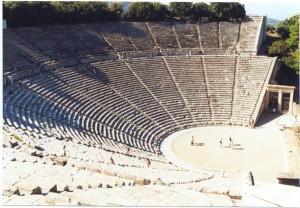Epidavros, a Visitor’s Impressions
 In a lush valley, encircled by friendly mountains, only 8 kilometers from Old Epidavros via a new road, I came to one of Greece’s most important archaeological sites that meets nature at its best. I think that the Sanctuary of Asklepios and the Ancient Theater, with the ruins of the Temple of Apollo Maleata behind it, truly rank among the world’s cultural treasures. In a lush valley, encircled by friendly mountains, only 8 kilometers from Old Epidavros via a new road, I came to one of Greece’s most important archaeological sites that meets nature at its best. I think that the Sanctuary of Asklepios and the Ancient Theater, with the ruins of the Temple of Apollo Maleata behind it, truly rank among the world’s cultural treasures.
The Sanctuary of Asklepios, the town’s largest official sanctuary of the city-state of Epidavros, was the most important, I hear, of all the sanctuaries dedicated to the god of Health. At its peak in the 4th century BC, its importance lasted for another thousand years. And it still provokes wonder. A visit to the archaeological museum, at the entrance to the site, and to the ruined monuments – the gymnasium, the Stoa [Arcade] of Kotyos, the small palaestra [wrestling field], the temples of Themis and Artemis, the abaton [untroddable area], the marvelous, unusual Tholos [Dome], the various buildings with arcades, the stadium, the temple of Asklepios – provide an ample explanation.
Nor far away, on the slopes of Mt. Kynortios, lies the miracle of Epidavros, the ancient theater. The most famous, but also the best preserved theater of antiquity, it was built in the 4th century BC, according to Pausanias, by the architect-sculptor from Argos, Polykleitos Junior; more modern research has proved this to be inaccurate, yet the name of the architect remains unknown. Its remarkable acoustics remain undiminished by the course of time, not only every word of the ancient drama plays is clearly heard, but also the joyful chatter of the pupils of a Greek school that happened to visit the theater at the same time I chose to. My Greek guide tries in vain to put a stop to this warbling of both children in the theater and birds around it. I did not find it at all annoying! I felt happy to witness a moment of the gigantic theater’s life, still vivid 2400 years after it was built. In any case, time has stopped here, since, every summer, the words of the ancient dramatists meet with eternity at the Epidavros Festival. I must plan another visit as a spectator of one of those artistic events…
|
|



